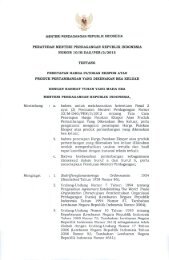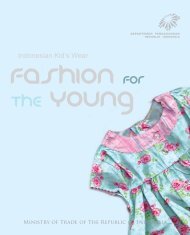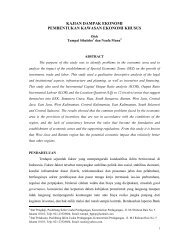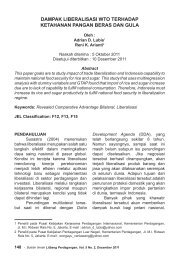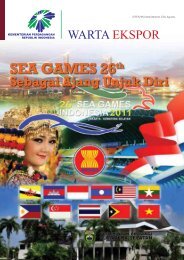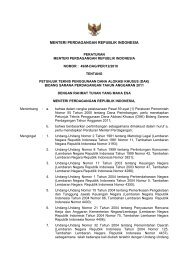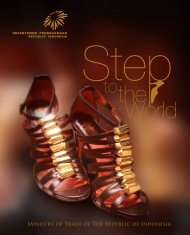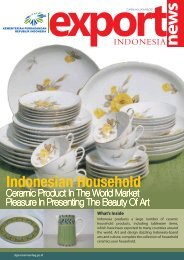Indonesia
Indonesia
Indonesia
You also want an ePaper? Increase the reach of your titles
YUMPU automatically turns print PDFs into web optimized ePapers that Google loves.
INDONESIA<br />
E C O N O M Y<br />
Creative n’ innovatioN<br />
<strong>Indonesia</strong><br />
from traditional to high tech designs<br />
<strong>Indonesia</strong> Good Design Mark is a guarantee for a product<br />
quality and a good design that are featured by the<br />
awarded product, which can give an added value for the<br />
product to be able to compete in the regional, national<br />
and international markets.<br />
TRADE RESEARCH AND DEVELOPMENT AGENCY<br />
MINISTRY OF TRADE REPUBLIC OF INDONESIA<br />
CREATIVE & INNOVATION INDONESIA 1<br />
productsdesign<br />
produk rev akhir.indd 1<br />
4/7/2009 6:11:03 PM
content<br />
FOREWORD<br />
Head of TREDA<br />
The Minister of Trade Republic of <strong>Indonesia</strong><br />
CREATIVE AND INNOVATION INDONESIA<br />
SECTION 1<br />
TO THE FRONTIER THAT KNOWLEDGE PERMITS<br />
SECTION 2<br />
THE BEGINNING OF INDONESIA PRODUCT DESIGN<br />
SECTION 3<br />
INDONESIA FOR THE WORLD<br />
SECTION 4<br />
INSTITUTIONAL DEVELOPMENT<br />
“Creative n’ innovatioN <strong>Indonesia</strong>”<br />
This booklet aims to present the potentialities of industrial design and profession in<br />
<strong>Indonesia</strong> and to confirm that those fields provide broad opportunities for the world market<br />
by promoting the excellent qualities of <strong>Indonesia</strong>n product designers and also helps to<br />
strengthen the bonds of trust that we are dedicated to continue building between <strong>Indonesia</strong>n<br />
industries, importers & exporters, distributors and buyers, and their counterparts in other<br />
countries around the world.<br />
Published In Jakarta, INDONESIA, 2009<br />
Publisher<br />
Trade Research & Development Agency<br />
Ministry of Trade Republic of <strong>Indonesia</strong><br />
2<br />
CREATIVE & INNOVATION INDONESIA<br />
produk rev akhir.indd 2<br />
4/7/2009 6:11:03 PM
Creative n’<br />
innovatioN<br />
<strong>Indonesia</strong><br />
Industrial product design in <strong>Indonesia</strong> has gone<br />
through levels of development and has gradually<br />
started to find its place in manufacture companies<br />
and the field of industry and trade in <strong>Indonesia</strong> and<br />
even abroad.<br />
Designers for (manufactured) consumer products<br />
hold an important role in industries as creators<br />
of products with competitive values. Today most<br />
industries in <strong>Indonesia</strong> have growing awareness<br />
in recognizing the role of designers, rather than<br />
copying designs from abroad.<br />
CREATIVE & INNOVATION INDONESIA<br />
3<br />
produk rev akhir.indd 3<br />
4/7/2009 6:11:03 PM
DEPARTEMEN PERDAGANGAN<br />
REPUBLIK INDONESIA<br />
Product and Industrial design has become one of today’s most important industrial sectors. It is both an art<br />
and a science. It is an integral part of the creation and manufacture of almost every commercial and noncommercial<br />
product made in the world. The surge in the development of mass production methods at the<br />
beginning the 20th century followed by decades of industrial modernization, began to include industrial<br />
design as a necessity in creating aesthetically pleasing, efficient, cost-effective and durable manufactures<br />
with a pre-determined lifespan.<br />
<strong>Indonesia</strong> is one of the world’s biggest markets – whether for consumer goods, agricultural tools, or industrial<br />
and manufacturing tools and equipment – and, like other societies, has its own specific requirements and<br />
expectations. Much of the country’s manufacturing sector replicates products designed for and marketed<br />
in other countries. This has created a situation whereby manufactured products, for whatever end-use, are<br />
not designed specifically for <strong>Indonesia</strong>n consumers, but for consumers in a different market.<br />
With increasing support from the government, educational institutions and other national professional<br />
organizations, <strong>Indonesia</strong>’s designers are gaining a foothold in what is essentially a foreign-dominated<br />
industrial sector. With their deeper understanding of <strong>Indonesia</strong>n culture and market, local industrial<br />
designers are better able to design manufactures that suit the needs and expectations of <strong>Indonesia</strong>n endusers.<br />
The industrial and manufacturing sectors have come to realize that talented and skilled local product<br />
and designers can play a vital role in developing new products or improving existing products, and thereby<br />
providing an economically viable way to increase sales not only in <strong>Indonesia</strong>’s domestic market, but also the<br />
Asia-Pacific market and even the global market.<br />
It is my strong hope that this book will contribute to further stimulating the development of <strong>Indonesia</strong>’s<br />
design industry. Government support and a strong focus on industrial design training by national education<br />
institutions must be at least equalled by a broader appreciation and application of industrial design from<br />
within the respective industries. Globalization provides access to the world’s markets and <strong>Indonesia</strong>n<br />
manufactures must be of the highest quality to be competitive both on the domestic and the international<br />
markets. Superior manufactures designed by <strong>Indonesia</strong>n professional product and industrial designers is<br />
one of the major factors toward achieving this noble aim.<br />
HEAD OF TRADE RESEARCH AND DEVELOPMENT AGENCY (TREDA)<br />
MUCHTAR<br />
4<br />
CREATIVE & INNOVATION INDONESIA<br />
produk rev akhir.indd 4<br />
4/7/2009 6:11:03 PM
MINISTER OF TRADE<br />
REPUBLIC OF INDONESIA<br />
Products and Industrial design is clearly one of <strong>Indonesia</strong>’s highly important functions in national<br />
development. Four decades of commitment and advancement have resulted in <strong>Indonesia</strong> having a growing<br />
number of professional, highly skilled and talented industrial product designers.<br />
The dedication of industrial designers and the institutions of higher education that provide them the<br />
facilities to learn and grow, is augmented by the support and collaboration of <strong>Indonesia</strong>n manufacturing<br />
industries. This framework of mutual support is beneficial in many ways, such as in <strong>Indonesia</strong>n product<br />
designers working productively, not only in <strong>Indonesia</strong>n industries, but for companies in other countries.<br />
Likewise, the the increasing number of product design students enrolling in design programs offered by<br />
<strong>Indonesia</strong>n institutions of higher learning strengthens these institutions, leading to further advancements<br />
in teaching methods and in the compilation of up-to-date information materials.<br />
However, perhaps the greatest benefit of all is to <strong>Indonesia</strong>n industries, which, with the support of<br />
professional industrial designers, are able to improve existing product design, develop newer and more<br />
sophisticated products, and strengthen their position in the domestic and global markets.<br />
The Government of <strong>Indonesia</strong> recognizes and appreciates the increasing capabilities and achievements<br />
of product designers, the institutions of higher education and the industries that collaborate and support<br />
this dynamic product design profession. The GoI is fully committed to supporting the further advancement<br />
of professional product design in every way possible and also to ensuring the highest level of protection<br />
of intellectual property rights, not only for <strong>Indonesia</strong>n product designs, but also for international product<br />
designs.<br />
As a final note, I sincerely welcome the publication of this booklet and hope that it will help to promote the<br />
excellent qualities of <strong>Indonesia</strong>n product designers and also helps to strengthen the bonds of trust that we<br />
are dedicated to continue building between <strong>Indonesia</strong>n industries, importers & exporters, distributors and<br />
buyers, and their counterparts in other countries around the world.<br />
MARI ELKA PANGESTU<br />
CREATIVE & INNOVATION INDONESIA<br />
5<br />
produk rev akhir.indd 5<br />
4/7/2009 6:11:03 PM
»<br />
one<br />
section<br />
to the frontier that knowledge p<br />
Garbarata<br />
The passenger boarding bridges which built in a wide<br />
variety of service length. While the standard equipment<br />
package is selected to meet the most airport operational<br />
requirements, available options make passenger boarding<br />
bridges suitable for every passenger need.<br />
6<br />
CREATIVE & INNOVATION INDONESIA<br />
produk rev akhir.indd 6<br />
4/7/2009 6:11:04 PM
Considering its nature as a discipline that is closely related to<br />
science and technology, the development of industrial design<br />
fields and knowledge is highly influenced by innovations and<br />
inventions. The scope is getting wider due to that fact, from<br />
daily products, electronic goods to transportation facilities,<br />
from household products to communication device and public<br />
facilities.<br />
permits<br />
Bicycle Toys<br />
<strong>Indonesia</strong> is a home for the art of miniature designs such as this bicycle toys. It is made from<br />
steel, rubber and silver.<br />
CREATIVE & INNOVATION INDONESIA<br />
7<br />
produk rev akhir.indd 7<br />
4/7/2009 6:11:09 PM
The term “design” came from the word disegno, which is known in Europe as sketches made by sculptors or painters before<br />
producing their sculptures or paintings. In recent times, the term design means activities in planning or constructing, from<br />
daily household products such as kitchen equipment, furniture, electronic gadgets, textile and clothings, to many other<br />
facilities such as automobiles, airplanes, farming tools, etc. The term design is already known among the <strong>Indonesia</strong>n<br />
society and is often mentioned in mass-media, such as newspapers and magazines, in relations to products that are<br />
marketed and offered to public, i.e. household products and clothings.<br />
The competence of industrial design is in the planning and design of utility products,<br />
with a purpose to solve problems related to human needs, always referring to both<br />
human comfort/ ergonomics and principles of industrial/ production processes.<br />
Human comfort or ergonomics includes sensing conformity, value and product<br />
semantics as well ascultural studies (material culture, lifestyle, etc.). During the design<br />
process, an industrial designer conducts an interdisciplinary collaboration, including<br />
aesthetics, social, technology, management, environment and science.<br />
Considering these facts, the recent development showed that industrial designers<br />
have come into affect many levels and variations of industries in <strong>Indonesia</strong>, respective<br />
to their interests and capabilities. The main key to success in any of those fields is to<br />
be original, inventive and creative.<br />
Formal training and higher education for industrial designers in <strong>Indonesia</strong> have been<br />
available for about 30 years. Among its graduates have found jobs in manufacture<br />
industries in <strong>Indonesia</strong>. Today, the Government of <strong>Indonesia</strong> has been endeavoring<br />
to optimize their competence and applied their capability optimally. At the same<br />
token manufacture industries start to realize the importance of producing their own<br />
designs in order to achieve added values for their products. These companies begin<br />
to recognize the role of industrial designers by employing products designers in their<br />
research and development (R&D).<br />
Designers for (manufactured) consumer products hold an important role in industries<br />
as creators of products with competitive values. Today most industries in <strong>Indonesia</strong><br />
have growing awareness in recognizing the role of designers, rather than copying<br />
designs from abroad.<br />
8<br />
CREATIVE & INNOVATION INDONESIA<br />
produk rev akhir.indd 8<br />
4/7/2009 6:11:09 PM
<strong>Indonesia</strong>n product designers have developed public phone casing. These casings<br />
will be placed on public places, such as transportation hubs e.g.airports or train<br />
stations, and street corners.<br />
Industrial design as a branch of knowledge started in the era of design methodology,<br />
in the 1960s. Sub-fields of design were modified in order to fulfill the reality of<br />
industrial needs: graphic design becomes visual communication design, interior<br />
design becomes architecture and environment design, and product design becomes<br />
system design, ergonomic design, design and culture – all of which exist under the<br />
term industrial design.<br />
Included in the fields of Industrial Design are:<br />
- Household goods (kitchen utensils, tableware, water dispenser, cleaning devices,<br />
etc.)<br />
- Working tools (wood-working facilities, hand-tools, farming equipment, etc.)<br />
- Furniture (indoor furniture, public facilities, shelters, etc.)<br />
- Product packaging (containers, etc.)<br />
- Transportation facilities (military vehicles, bicycles, cars, trains, ships, ATVs,<br />
airplanes, etc. and their parts/elements)<br />
- Electronic products (gadgets, televisions, audio/video systems, etc.)<br />
- Applied crafts, “new crafts” (simple utensils, home elements, souvenirs, etc.)<br />
- Medical equipment (first-aid sets, dental seats, prevention devices, etc.)<br />
- Office equipment (furniture, working desks, lighting, etc.)<br />
- Sport equipment (training facilities, shoes, etc.)<br />
- Playthings, toys (manual & tactile, electronic games, etc.)<br />
- Sanitary equipment (bathtub, wash tables, shower heads, etc.)<br />
- Tableware (cutlery sets, stationary, etc.)<br />
- Fashion accessories (belts, jewelries, bags, etc.)<br />
- Educational tools, emergency tents, rescue device, etc.<br />
CREATIVE & INNOVATION INDONESIA<br />
9<br />
produk rev akhir.indd 9<br />
4/7/2009 6:11:09 PM
Most part of <strong>Indonesia</strong> often founded<br />
traditional toys which made from natural<br />
materials.<br />
Basically all products that are directly operated by human beings; products that<br />
should be able to inform the users about how to operate/handle them (which button<br />
to push, what direction should the leverage be pulled, how to tell that the battery is<br />
fully recharged and so on), directly from their shapes and forms.<br />
Products that should provide appropriate sensations at particular, expected moments<br />
from their users, who should be able to react accordingly. (i.e. a car driver should sit<br />
comfortable enough to drive, but not too comfortable that he would fall asleep during<br />
driving; or a chef should be comfortable, alert and safe enough to work on her stove in<br />
a professional kitchen under time and space pressures). Industrial Design is a bridge<br />
between human beings and machines and tools.<br />
In <strong>Indonesia</strong>, the profession of industrial design emerged since the establishment of<br />
formal higher education for industrial designers in 1972 at the Faculty of Arts and<br />
Design, ITB. Its alumni gradually fill various careers, among others in manufacture<br />
industries, both international and national scales, such as in auto- or motor-parts<br />
industry, sanitary equipment and electronic products companies, and even in airplane<br />
industry and military devices and vehicles factories.<br />
A number of graduates also established their own design consultancy bureaus and<br />
enterprises, mostly for consumer products. Some others are dedicating themselves<br />
into the field of education and research, in order to regenerate industrial design<br />
professionals and/or to increase and update knowledge in the fields of industrial<br />
design.<br />
10<br />
CREATIVE & INNOVATION INDONESIA<br />
produk rev akhir.indd 10<br />
4/7/2009 6:11:10 PM
Air Filter is designed to increase horsepower and acceleration while providing excellent filtration. It<br />
is custom designed to fit into an existing factory air box and features a drop-in design which means<br />
adding performance is simple, provides high air flow with excellent filtration as well as Economical and<br />
environment friendly.<br />
The competence of industrial design is in the<br />
planning and design of utility products, with a<br />
purpose to solve problems related to human<br />
needs, always referring to both human comfort/<br />
ergonomics and principles of industrial/<br />
production processes.<br />
The recent development showed that industrial<br />
designers have come into affect many levels and<br />
variations of industries in <strong>Indonesia</strong>, respective<br />
to their interests and capabilities. The main key<br />
to success in any of those fields is to be original,<br />
inventive and creative.<br />
CREATIVE & INNOVATION INDONESIA<br />
11<br />
produk rev akhir.indd 11<br />
4/7/2009 6:11:10 PM
»<br />
two<br />
section<br />
The emergence of creative economy,<br />
craftsmen and home industries. The<br />
crafts industries should be empower<br />
with production process/method and<br />
product innovation to alleviate it from<br />
conventional industries to become high<br />
added value creative industries<br />
Wayang is an <strong>Indonesia</strong>n word for theatre. When the term is used to refer to<br />
kinds of puppet theater, sometimes the puppet itself is referred to as wayang.<br />
“Bayang”, the Javanese word for shadow or imagination, also connotes<br />
“spirit.” Performances of shadow puppet theater are accompanied by gamelan<br />
in Java, and by “gender wayang” in Bali.<br />
12<br />
CREATIVE & INNOVATION INDONESIA<br />
produk rev akhir.indd 12<br />
4/7/2009 6:11:12 PM
the beginning of<br />
<strong>Indonesia</strong><br />
products design<br />
CREATIVE & INNOVATION INDONESIA<br />
13<br />
produk rev akhir.indd 13<br />
4/7/2009 6:11:15 PM
Stationery products have a very important role<br />
in almost every sector of people’s activity. large<br />
amount of these products are used in offices<br />
for running daily works, in banks, schools<br />
and universities. Accordingly, industries that<br />
produce stationery products are also increasingly<br />
developing.<br />
FROM TRADITIONAL CRAFTS TO INDUSTRIAL DESIGN<br />
The agricultural life that used to dominate the <strong>Indonesia</strong>n archipelago had to give<br />
way to the increasing number of population. Domestic needs grow and need more<br />
space, pushing rice fields and plantations into smaller parcels to provide space for<br />
housing, shops, etc. Farmers no longer have enough soil to work on that can gain<br />
enough income to sustain a family. Farmers and plantation workers were compelled<br />
to find another source of income in order to survive.<br />
It is a common fact that, in spending time between tending the fields and plantations,<br />
farmers in rural areas conduct activities such as making and mending working tools<br />
and household goods, or performing traditional arts and rituals – mostly related<br />
to creating artifacts, relying upon generations-length, handed-down knowledge<br />
and skills. This capability is what they use to survive once a farmed land is reduced<br />
in width, or even diminished, and is impossible to make a living from. They started<br />
selling the tools and goods they produce to ‘external buyers’ (people who are not<br />
directly involved in the culture or process of producing the tools and goods), not for<br />
their original functions, but as souvenirs and/or to fulfill other utilities determined<br />
by the buyers. Existing traditional skills and artifacts then became commodities, and<br />
farmers and their family become craftsmen in a home-industry scale operation.<br />
A point came when the commodities become stagnant and the buyers are looking<br />
for new products. The craftsmen attempt to accommodate the buyers’ demands by<br />
modifying the products, applying variations of elements, details and colors. However,<br />
not all modified products could fulfill the tastes and needs of the buyers, moreover if<br />
they come from very different background and culture. This fact is a common cause<br />
for a discontinuity of home industries that are based on local natural resources,<br />
traditional production process and limited references. This is actually where industrial<br />
designers could intervene.<br />
Industrial designers with formal education would already have learned about product<br />
analysis and possess a certain level of aesthetics, moreover from being exposed and<br />
14<br />
CREATIVE & INNOVATION INDONESIA<br />
produk rev akhir.indd 14<br />
4/7/2009 6:11:15 PM
having access to unlimited information. They could help assist craftsmen in improving<br />
their products in order to fulfill demands from contemporary market and the whole<br />
system around it (i.e. distribution, promotion, contract, management, etc.). This,<br />
however, will work only when the industrial designers are capable of recognizing local<br />
potentials, making correct analysis towards the products and applying technology<br />
that is appropriate for the local conditions.<br />
Prior to the afore mentioned conditions, formal education in industrial design is<br />
pioneered by teaching staffs of the Faculty of Arts and Design ITB who originally<br />
learned to be drawing/painting teachers. They were sent abroad, mostly to the United<br />
States, to learn about industrial design and to apply the knowledge in <strong>Indonesia</strong>.<br />
However, the basic of the knowledge mostly come from Western (American and<br />
European) cultures, along with their ideologies, which are being taught to industrial<br />
design students already for about thirty years. As a consequence, up to recent times,<br />
graduates of industrial design are lack of knowledge concerning <strong>Indonesia</strong>’s own<br />
material resources, artifacts and traditional production systems. This point is what<br />
makes it difficult for designers to start intervening the home industries such as the<br />
ones mentioned beforehand. Realizing the disadvantages, current industrial design<br />
students are given materials about local contents as well, which has broadened the<br />
viewpoints of new graduates.<br />
INDONESIAN DESIGN PARADIGM<br />
Design development in many parts of the world has shown significant progress,<br />
especially due to the innovation of advanced technology and material inventions,<br />
along with development of design concepts and philosophies. As a consequence,<br />
designs that were created in the 20th century, which used to retain ornamental<br />
appearances, gradually appeared in simpler forms and in more efficient, practical,<br />
durable and affordable conditions. The 20th century is also known as an era of<br />
competition, therefore manufacture industries started to recognize the role of design<br />
in capturing and creating (new) markets.<br />
Design products have also embedded in our daily lives and have become our routine<br />
needs, such as houses, cars, television sets, chairs, wristwatch, etc. Questions concerning<br />
the competitive capability of <strong>Indonesia</strong>n design raise, especially considering the fact<br />
that <strong>Indonesia</strong> has an abundance of human, natural and cultural resources, and a<br />
strategic geo-political position. In this context, design is not merely applied to the<br />
quantitative value of a particular product, but as a media that represents the level of<br />
civilization of its country of origin. Considering that matter, design needs to have the<br />
following basis, which should work as a compact system and a total process:<br />
•<br />
•<br />
•<br />
•<br />
National awareness towards design<br />
Natural and human resources<br />
Technology and industry<br />
Strategy and policy from a national design council<br />
CREATIVE & INNOVATION INDONESIA<br />
15<br />
produk rev akhir.indd 15<br />
4/7/2009 6:11:15 PM
advancing people<br />
TO THE LEVEL THAT TECHNOLOGY PERMITS<br />
<strong>Indonesia</strong>n product designers catch up with the<br />
most advanced technology. Today, they are involve<br />
in the process of improving national industries,<br />
manufactured products, production processes and<br />
systems by employing the latest technology.<br />
<strong>Indonesia</strong> rolled out its new N250-100 turboprop<br />
airplane. What then began as a narrowly focused<br />
program to develop a robust short-field turboprop to<br />
help unite the undeveloped archipelago has grown<br />
into a much broader effort.<br />
16<br />
CREATIVE & INNOVATION INDONESIA<br />
produk rev akhir.indd 16<br />
4/7/2009 6:11:17 PM
N-250 Cockpit<br />
The N-250 was launched at the 38th Paris Air<br />
Show in 1989, following a market evaluation<br />
that began in 1987. That study resulted in a<br />
decision in 1989 to proceed with development of<br />
the N-50. The first metal for the initial prototype<br />
was cut in August 1992. First flight of the initial<br />
N-250 prototype was in August 1995. This first<br />
flight of the initial prototype, a 50-seater, and the<br />
second N-250 prototype made its initial flight<br />
in December 1996. It was built in the stretched<br />
N-250-100 configuration.<br />
The N250 turboprop carrier was the pride of <strong>Indonesia</strong>. Its maiden flight exactly a<br />
week before the 50th anniversary of <strong>Indonesia</strong>’s declaration of independence from<br />
the Dutch, The first flight of the N-250 turboprop was in August 10 1997. It is the<br />
first commercial aircraft designed and made completely by <strong>Indonesia</strong>n engineers<br />
and technicians. The plane’s designer, state-owned IPTN Industri Pesawat Terbang<br />
Nusantara (<strong>Indonesia</strong>), wanted to market the 64-68 seat aircraft worldwide.<br />
The airframe was fabricated from aircraft light alloys and titanium with a significant<br />
portion of nonstructural components of composite materials. The fuselage was<br />
derived from that of the CN-235, although it was wider and taller. The wing, tail,<br />
and engine nacelles were all-new designs. The wing included double-slotted fixed<br />
vane flaps and wing spoilers for STOL enhancement. Standard avionics equipment<br />
included the Rockwell Collins Pro Line 4 avionics system. This system featured five<br />
large CRT displays that provide primary flight, navigation, engine, and aircraft status<br />
information. Fly-by-wire technology was used for the primary and secondary flight<br />
control systems.<br />
CREATIVE & INNOVATION INDONESIA<br />
17<br />
produk rev akhir.indd 17<br />
4/7/2009 6:11:19 PM
»<br />
three<br />
section<br />
TO THE LIMIT THAT MARKET PERMITS<br />
On entry into service, in 1974, the A-300, was very advanced and influenced later<br />
subsonic airliner designs. The technological highlights among others: 2-man crew<br />
by automating the flight engineer’s functions, an industry first (a request made<br />
by Garuda <strong>Indonesia</strong>, an idea proposed by B. J. Habibie, who at that time was<br />
<strong>Indonesia</strong>’s Minister of Research and Technology); High degree of automation,<br />
requiring the flight engineer’s intervention only in an emergency situation; and<br />
the first airliner to use winglets for better aerodynamics. Those technologies are<br />
implemented in further series of Airbus sub sonic aircraft.<br />
18<br />
CREATIVE & INNOVATION INDONESIA<br />
produk rev akhir.indd 18<br />
4/7/2009 6:11:19 PM
<strong>Indonesia</strong><br />
for the world19<br />
CREATIVE & INNOVATION INDONESIA<br />
produk rev akhir.indd 19<br />
4/7/2009 6:11:20 PM
Home Appliances<br />
The roles of <strong>Indonesia</strong> home appliance designer is<br />
reputable in the global industry. Beyond their exotics and<br />
internationally acceptable designs, the capabilities of<br />
meeting worldwide products standard have been crucial<br />
in establishing <strong>Indonesia</strong> designers equity in the world<br />
market. <strong>Indonesia</strong> export for electrical and non electrical<br />
home appliances to the world market has been growing<br />
significantly in the recent years.<br />
Tools & Utilities<br />
Garbarata passenger boarding bridges are designed to<br />
meet all applicable codes and standards. The passenger<br />
boarding bridges are available in steel and glass<br />
models. In general, Garbarata products conform to the<br />
mechanical and electrical standards of : NFPA, ASTM,<br />
NEC,NEMA, AWS, SAE, JIS, SII, ISO 90<br />
20<br />
CREATIVE & INNOVATION INDONESIA<br />
produk rev akhir.indd 20<br />
4/7/2009 6:11:22 PM
Living Naturally<br />
<strong>Indonesia</strong>’s furniture, particularly the<br />
rattan furniture products, have been<br />
exported to more than 200 countries<br />
around the world.<br />
Safety & Fresh<br />
As the impact of technology improvement in many sectors,<br />
nowadays of packaging are provided in various types, in line<br />
with increasing of FMCG (Fast Moving Consumer Goods), so<br />
that the producers of packaging are tightly competing to create<br />
innovation in their designs. Many kinds of packaging materials,<br />
such as paper, plastic, etc are mostly used. To preserve the quality<br />
and security of the products being packed, it needs food grade<br />
packaging which will meet the food safety standard.<br />
CREATIVE & INNOVATION INDONESIA<br />
21<br />
produk rev akhir.indd 21<br />
4/7/2009 6:11:26 PM
Mobility & Comfort<br />
Comfortable goes together with safety. <strong>Indonesia</strong> industrial<br />
design contributes to many well known national and<br />
international manufactures. From aeronautic industries to<br />
simple appliance products. From daily life style fashion to<br />
modern military equipments.<br />
State of The Art<br />
The PT Pindad designed Panser used a monocoque hull design<br />
consisting of steel composites. A new torsion bar suspension<br />
system was also developed for the Panser. Currently, the engine and<br />
transmission are imported from Renault.[1] Indigenous options are<br />
being developed as replacements. The driver sits on the right of the<br />
vehicle while the vehicle commander sits on the left.<br />
PT Pindad plays strategic role in providing the country with military<br />
as well as civilian heavy duties equipments.<br />
22<br />
CREATIVE & INNOVATION INDONESIA<br />
produk rev akhir.indd 22<br />
4/7/2009 6:11:31 PM
Health Access for All<br />
The development and production of medical equipments are<br />
one of <strong>Indonesia</strong> national priority in advancing health for all.<br />
The country possess capability in designing and producing<br />
various medical equipments, tools and hospital components. The<br />
country’s national industries have been acknowledged by many<br />
countries for supplying reputable medical equipments.<br />
Simply Distinctive<br />
Exotic ally designed, the plaited crafts packaging are produced in nearly<br />
all parts of <strong>Indonesia</strong>. Plaited craft industries with large scale production<br />
are found in certain provinces such as West Java, Central Java, East Java,<br />
Yogyakarta, Bali, West Nusa Tenggara, South Sulawesi, Jambi, Lampung,<br />
Riau, West Kalimantan, and Central Kalimantan.<br />
CREATIVE & INNOVATION INDONESIA<br />
23<br />
produk rev akhir.indd 23<br />
4/7/2009 6:11:34 PM
Touch of The Finest<br />
<strong>Indonesia</strong>n products designers utilises natural materials<br />
in most of their creations. <strong>Indonesia</strong> has produced and<br />
exported various natural based stationery products to<br />
the markets around the world. The products exported by<br />
<strong>Indonesia</strong> included exercise books, ballpoints, pencils,<br />
markers, letter corners, letter or paper clips, etc.<br />
For Better Life<br />
Since many decades <strong>Indonesia</strong> has<br />
developed shoe industry for domestic and<br />
export purposes. <strong>Indonesia</strong> has produced<br />
and exported various kinds of footwear<br />
such as casual shoes, uniform boots,<br />
women’s shoes, children shoes, and sport<br />
shoes. They are made of leather, rubber or<br />
combination of those two materials, and<br />
some footwear also combined with textile<br />
materials.<br />
24<br />
CREATIVE & INNOVATION INDONESIA<br />
produk rev akhir.indd 24<br />
4/7/2009 6:11:36 PM
Living Naturally<br />
<strong>Indonesia</strong>n toiletries products, namely bath<br />
and shower products, accounted for the bulk to<br />
toiletries value sales in <strong>Indonesia</strong> over the review<br />
period. <strong>Indonesia</strong>n consumers generally regard<br />
these products as basic necessities, and thus the<br />
consumer base, are huge in comparison with less<br />
essential products. As demand for these products<br />
was already considered saturated, manufacturers<br />
came up with product innovations such as new<br />
design as well as specification with value-added<br />
benefits, and novel packaging designs and formats<br />
to spice up growth and win share.<br />
Fun-tainment<br />
<strong>Indonesia</strong>n toys have continued to see a growing<br />
demand from the export market. There are some<br />
different types of toys which <strong>Indonesia</strong> exports, and<br />
these include wheeled toys, dolls and accessories,<br />
objects in miniature such as electric railway trains,<br />
assembly kits, construction kits, and musical<br />
instruments.<br />
CREATIVE & INNOVATION INDONESIA<br />
25<br />
produk rev akhir.indd 25<br />
4/7/2009 6:11:39 PM
»<br />
four<br />
section<br />
Association for industrial design professionals has been<br />
established since 1983, whose numbers are increasing year-toyear.<br />
Moreover, it is necessary to facilitate professional designers<br />
who work as both consultants and employees in industries. This<br />
initiation resulted in the establishment of Persatuan Akhli Desain<br />
Industri <strong>Indonesia</strong> - Union of <strong>Indonesia</strong> Industrial Designers (PADII)<br />
in October 1983.<br />
institutional developm<br />
In 1984, based on initiatives of various parties, the establishment of PADII was<br />
considered premature due to the limited amount of eligible members. The<br />
Supervision Council suggested for PADII to change its name into Forum Desainer<br />
Industri - Forum of Industrial Designers (FDI) in 1985, of which when the amount of<br />
its members reaches more than one hundred, a new, more potential organization<br />
can be formed. In 1988 the first congress for <strong>Indonesia</strong>n industrial designers were<br />
held, attended by more than 200 designers. In this congress, the name Ikatan<br />
Desainer Produk <strong>Indonesia</strong> (IDPI) was declared, along with its article of association<br />
and professional ethics code. The organization was later changed into Asosiasi<br />
Desainer Produk <strong>Indonesia</strong> - Association of <strong>Indonesia</strong> Product Designers (ADPI).<br />
Leverages in the making<br />
The working program of ADPI is mainly to gather as many members as possible,<br />
based on the agreed requirements. Its main office used to be at Jl. Ganesha,<br />
Bandung, then later in Jakarta Design Center building, Jakarta. ADPI activities have<br />
become vacuum, until in 1995 several members of ADPI held a congress, where<br />
Taufik Ibrahim was elected as the new ADPI chair. Two years afterward, Mizan Alan<br />
de Neve was appointed as a new chair. During this era, ADPI represented <strong>Indonesia</strong><br />
in a number of ICSID meetings and exhibitions in International Design Forum in<br />
Singapore, and has published several bulletin of ADPI Jakarta activities.<br />
26<br />
CREATIVE & INNOVATION INDONESIA<br />
produk rev akhir.indd 26<br />
4/7/2009 6:11:40 PM
ment productsdesigner ...<br />
emerged as a title for people who<br />
have completed a formal education and<br />
training that specifies in product design<br />
knowledge and skills.<br />
Professionally,<br />
a designer is responsible not only for creating<br />
products that are useful and can function well,<br />
but also products that are safe,<br />
comfortable and attractive for users.<br />
CREATIVE & INNOVATION INDONESIA<br />
27<br />
produk rev akhir.indd 27<br />
4/7/2009 6:11:42 PM
Future roles of ADPI have become significant, since Industrial Design already possess a<br />
strong legal foundation in facing the dynamic global market. Moreover, ADPI takes part<br />
in controlling the application of Industrial Design Constitution and in supervising the<br />
accreditation and professional standards of higher education in design.<br />
ADPI missions:<br />
1. As an association for all industrial designers in <strong>Indonesia</strong><br />
2. To facilitate communications among and inter-professions<br />
3. To achieve the organization visions and missions<br />
4. To conduct various programs that are relevant to the improvement of industrial<br />
design reputation and professionalism<br />
5. To widen information networks that are relevant to industrial design<br />
6. To undertake quality improvement of ADPI members<br />
Facing the free market in South East Asia, ADPI is expected to determine steps for<br />
professional competence standards for both foreign industrial designers who work in<br />
<strong>Indonesia</strong> and <strong>Indonesia</strong>n industrial designers who work abroad. ADPI also provides<br />
protection for members who undergo professional disadvantages by forming a<br />
Professional Ethics Code Council, who acts as a normative legislation related to<br />
members and foreign professional practice. ADPI was once registered as a member of<br />
International Council of Society of Industrial Design (ICSID), which has access to other<br />
industrial design organizations in the world.<br />
Compared to industrial design professional associations in other countries, it is apparent<br />
that the professional association in <strong>Indonesia</strong> is remain infant. However, this condition<br />
does not reflect the increasing role of <strong>Indonesia</strong>n industrial designers.<br />
Industrial Design in <strong>Indonesia</strong> and the Global Market<br />
In order to be able to compete in the global market, a product should possess innovative<br />
values next to physical qualities and visual attractiveness, which are actually industrial<br />
designers’ lines of work. An apparent change of appreciation towards industrial design<br />
in <strong>Indonesia</strong> was triggered when the international trade started to take effect in the<br />
1990s, where all commercial goods and commodities should have clear copyrights<br />
and patents. Manufacture industries in <strong>Indonesia</strong> could no longer imitate designs and<br />
products from abroad, then claim and sell them as their own work. In order to survive,<br />
these companies should buy licenses from companies whose products are being<br />
produced and distributed in <strong>Indonesia</strong>, or have its own division that concentrates on<br />
product development.<br />
<strong>Indonesia</strong>n industrial product designers are now gradually in their ways toward widers<br />
opportunities. Creativity is obviously involved, in order to success. Considering the rich<br />
<strong>Indonesia</strong> is with cultures and traditions, it is obvious that inspirations could be cope<br />
with and should be accompanied by a skill to innovate and to find new solutions, and a<br />
sense of entrepreneurship that makes it possible to survive and to move forward.<br />
28<br />
CREATIVE & INNOVATION INDONESIA<br />
produk rev akhir.indd 28<br />
4/7/2009 6:11:42 PM
To achieve a recognized position in the global market, creativity and innovation should<br />
be added with advanced technology mastery, with which product improvement<br />
depends upon. Advanced technology at most times determines standards of certain<br />
products, i.e. a product that uses non-toxic, biodegradable resin as adhesive substance<br />
could gain the label of ‘ecological product’ and could enter certain market, while similar<br />
products that uses common resins fail to gain the label and therefore are not allowed to<br />
be distributed in these particular market.<br />
Today, the Government of <strong>Indonesia</strong> has been persistence in implementing policy to<br />
expand the access of <strong>Indonesia</strong>n designers to the necessary information, knowledge,<br />
technology and resources, particularly in the remote areas of <strong>Indonesia</strong>’s vast<br />
archipelago. The GoI also enhancing the country capacity to accommodate law<br />
enforcement in recognizing intellectual copyright.<br />
<strong>Indonesia</strong> Law number 31 year 2000 on Industrial Design provides intellectual copyrights<br />
protection for an industrial design. It is stated in the institution that industrial design is:<br />
a creation of form, configuration or composition of lines or colors or lines and colors<br />
or a combination of line and colors in three-dimensional or two-dimensional, which<br />
provides an aesthetical impression and can be used to produce a product, a good, an<br />
industrial commodity or a craft work.<br />
Protection is provided for industrial designs that are: new and considered new (based on<br />
the registration date). Protection is not available for industrial designs that are against<br />
effective law, public order, religion and ethics.<br />
The law provides a term of ten years protection of the rights, dated since the acceptance<br />
of the design, including: the rights to possess the design and to prohibit others without<br />
permission to produce, use, sell, import, export and/or distribute a part or more of a<br />
design that has already given the copyrights. The subjects of the law are designers,<br />
whether individually or as a team, or persons that are appointed as the beneficiary of<br />
the rights, institutions and commissioners.<br />
The Law is currently undergoing a process of amandement, in order to determine more<br />
clearly the definition and scope of “industrial design” that is appropriate for <strong>Indonesia</strong>.<br />
Advancement Through Education<br />
The first higher education in industrial design was first established in Institute of<br />
Technology Bandung in 1972, under the name of Product Design Studio. In 1996 the<br />
studio applied and was registered as a member of International Council of Society of<br />
Industrial Design (ICSID). In 1998 the Product Design Studio raised its level to be Product<br />
Design Study Program (PSDP), accompanied by improvements in curriculum and<br />
strategies in order to face future challenges.<br />
Up to today, higher education in industrial design gradually increases in various cities in<br />
<strong>Indonesia</strong>. Among the largest ones are at Trisakti University, Paramadina University and<br />
Pelita Harapan University (UPH) in Jakarta, Institut Teknologi Sepuluh Nopember (ITS) in<br />
Surabaya and Institut Teknologi Nasional (Itenas) and Maranatha University in Bandung.<br />
CREATIVE & INNOVATION INDONESIA<br />
29<br />
produk rev akhir.indd 29<br />
4/7/2009 6:11:42 PM
Alumnis of these schools have taken various occupations, mainly becoming industrial<br />
designers in companies, establishing their own enterprises, or becoming lecturers and/<br />
or researchers.<br />
The current relationship between the academics field of industrial design and<br />
manufacturing industries is heading towards a positive synergy, considering active<br />
competitions, seminars, etc. that are held in collaboration with various companies.<br />
Collaborations with industries are commonly in the form of design competitions,<br />
workshops, seminars and exhibitions. On one hand, manufacture industries start to<br />
appreciate and to see the importance of regularly having new, innovative design to<br />
improve their products. On the other hand, students could learn real situations in the<br />
field of manufacture industries.<br />
Relations with these industries are usually maintained via graduates who work at the<br />
company and open an access for collaborations. Manufacture industries that can be<br />
flexible in conducting this kind of collaboration are those that are owned by <strong>Indonesia</strong>n<br />
and have its own R&D section, and not merely a license holder of a foreign company.<br />
Marketing and Promotion Strategy<br />
Commodity products can be promoted through a variation of events, such as trade fairs<br />
and exhibitions, for both national and international markets. Next to the events, products<br />
can also be promoted via website and Internet portals to reach wider markets.<br />
Another promotion is through awards, where certain products are awarded certain<br />
recognitions from authorized, entitled organizations, i.e. the <strong>Indonesia</strong>n Good Design<br />
Selection (IGDS) by the National Design Center (Pusat Desain Nasional/PDN).<br />
<strong>Indonesia</strong> Good Design Selection (IGDS) is a selection system for <strong>Indonesia</strong>n Good<br />
Design as an effort to increase appreciation towards design and trust towards <strong>Indonesia</strong>n<br />
product quality. IGDS is an annual event, held by the National Design Center, as a part<br />
of strategic steps to promote and develop design in a national scale. IGDS gives the<br />
highest awards in design for <strong>Indonesia</strong>n products that have been produced through a<br />
research and development process.<br />
IGDS could initiate the needs and importance of design in quality products for<br />
entrepreneurs or industrial products manufacturers. IGDS is expected to be able to<br />
accelerate creative and innovative efforts of industrial designers in creating high-quality<br />
designs, in order to increase the competitive image of <strong>Indonesia</strong>n products and to<br />
provide added values in regional, national and international markets.<br />
IGDS is held by the National Design Center, collaborating with the <strong>Indonesia</strong>n<br />
Department of Industry, Department of Trade and Japan International Cooperation<br />
Agency (JICA). IGDS is also supported by <strong>Indonesia</strong>n professional designers associations<br />
and (financially) by industry sectors.<br />
30<br />
CREATIVE & INNOVATION INDONESIA<br />
produk rev akhir.indd 30<br />
4/7/2009 6:11:42 PM
When Excellent is Possible<br />
<strong>Indonesia</strong> Good Design Mark is a guarantee for a product quality and a good design that<br />
are featured by the awarded product, which can give an added value for the product to<br />
be able to compete in the regional, national and international markets.<br />
Next to the <strong>Indonesia</strong> Good Design Mark, trophies and certificates are also granted for<br />
the following categories:<br />
- GRAND AWARD of INDONESIA GOOD DESIGN – Given to the “best of the best”<br />
product, given to one product among other nominated products<br />
- GOLD AWARD of INDONESIA GOOD DESIGN – Given to the best product of each<br />
category. Products with a Gold Award have the right to display the <strong>Indonesia</strong> Good<br />
Design label<br />
- THE BEST SME PRODUCT – Given to a product manufactured by a small- or medium<br />
enterprise<br />
- EXPORT PRODUCT AWARD – Given to a product that already has an export<br />
market and is already considering Design as a tool to increase competitiveness in<br />
international market<br />
Moreover, products that received the awards are registered to compete in Good<br />
Design Award ASEAN Design Selection (G-mark for ASEAN countries). This G-mark with<br />
Japanese system is an actual form of recognition towards <strong>Indonesia</strong>n products with<br />
high quality. <strong>Indonesia</strong>n products that won IGDS in 2002, 2003 and 2004 are among the<br />
products that were selected to receive the award; which means that these products are<br />
internationally recognized as being able to compete with foreign products.<br />
CREATIVE & INNOVATION INDONESIA<br />
31<br />
produk rev akhir.indd 31<br />
4/7/2009 6:11:42 PM
www.depdag.go.id<br />
email: treda@depdag.go.id<br />
sesbalitbang@depdag.go.id<br />
Ministry of Trade Republic of <strong>Indonesia</strong><br />
Jl. M.I. Ridwan Rais No. 5 Main Building - 4th Floor<br />
Jakarta 10110 INDONESIA<br />
Telp. : [62-21] 2352 8691<br />
Fax. : [62-21] 2352 8691<br />
produk rev akhir.indd 32<br />
4/7/2009 6:11:42 PM



